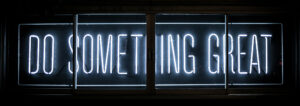



The internet and digital technology have opened up new opportunities for B2B businesses, and as the way people discover, consider and interact with brands has changed, the channels B2B has traditionally operated in have shifted too.”
There are two driving forces behind this. Firstly, digital channels have made a broader range of media available to smaller and more specialised brands, and there’s no barrier to entry for those on a tight budget.
The second is addressable media. Taking out a mass-reach linear TV ad to reach only a few relevant people might have been overkill for a specialist B2B company back in the day, but now they can use data to identify and target potential customers across digital channels, including addressable TV.
So, B2B businesses no longer have to wait for customers to come to them, meaning creativity and brand-building in B2B is now more important than it has ever been before. Firms have the opportunity to build a relationship with customers that goes beyond the functional and can reap the rewards, just like consumer-facing brands.

It’s not just an opportunity; it’s a necessity. As technology has levelled the playing field so businesses can speak to just about anyone, a distinctive offering that stands out among the noise is now critical for B2B firms. This can be at a functional level in terms of product superiority or lower price but, generally, B2B brands need to find a way to stand out or customers will just chop and change. Held up against the rich creative backdrop of social media, online video and TV, traditional sales-led, functional advertising feels dated.
Customers’ expectations of B2B brands have also evolved, just as they have of consumer brands. If you book a holiday, you expect all the touchpoints you engage with to work seamlessly together. If it’s clunky, you’ll drop out and go elsewhere. As consumers we have high standards, and that has influenced expectations of B2B brands too.
People no longer distinguish between consumer and business brands when it comes to their experience. They might have their work hat on rather than their consumer hat, but how they see and judge those brands is the same. We want to be entertained, to feel something, and to be given an excellent customer experience.




If consumers don’t distinguish between B2B and B2C, B2B firms shouldn’t either. Your customers might be different, but the importance of brand – and using creativity as a vehicle to build it – is the same.”
The brands leading the change
While B2B broadly has a major catch-up job to do, there are some brands which are well ahead of the curve. SME-focused business software firm Sage has invested in creativity for years, even running the first B2B ad campaign on TikTok in 2020. And it’s reaping the rewards of that – in May, it credited its marketing approach by helping to deliver double-digit jumps in revenue and profit.
Similarly, small business platform Xero kicked off its first major UK brand campaign in 2021, casting comedian Rhys Darby as the star of its tongue-in-cheek ads – potentially signalling more ‘borrowed interest’ and influencer marketing.
Often, the best examples of creativity in B2B are the brands which are, on the face of it, quite boring. Adobe, for example. Computer software isn’t exactly exciting. But everyone knows the brand, and that’s in part thanks to ads like this classic spot from a decade ago.
It’s not just the buyers in B2B who are important, but the end-consumer too. That’s what makes Adobe so clever – they’ve built their brand as one consumers look out for when buying their laptops and computers.
There are traps B2B can fall into, however. You need to get your messaging hierarchy right. If your business hasn’t established its function, you can’t jump the gun and set out an unclear, vague proposition. I recently saw a cloud software brand not get this right. They’d gone for an emotional articulation of their ‘future of tech’ proposition but hadn’t earned the permission by setting out their functional offering first.
This ability to push your message as a brand is earned over time; if an unknown brand shoots straight out of the gate with a campaign that tries to be too clever, it rarely lands well. For some, the starting point of brand-building will be a case of refining how your brand is presented at touchpoints like your website.
But crucially, creating engaging brand work is utterly pointless if your product or service isn’t worth buying. B2B buyers often put in orders worth thousands of pounds at a time; if they get stung, they won’t return. The classic brand marketing rules still apply: get your product in order first, then drive people to it.


What does the future hold for B2B creativity?
When social and digital channels first started gaining traction, small consumer brands suddenly had the chance to reach people who had never heard of them. Their small marketing budgets were no longer a barrier; from there, we saw an explosion in fast-growing challenger brands.
We’re now seeing a similar trend in B2B, and it won’t slow down. As more and more B2B businesses turn into B2B brands, the competition will only become more intense. Marketers must therefore be creative – and potentially provocative – to get attention.




Brand-building is next on the horizon for B2B businesses to aim towards, and creativity is a powerful tool to accelerate their progress. It’s a journey that needs to begin today; brands that are slow to get started will end up falling behind their competition.”
Being the first to move in a category can feel risky, but the only thing riskier is to find yourself moving last.



